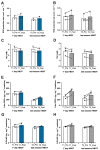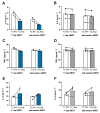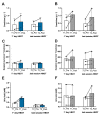Hyperbaric Oxygen Therapy Counters Oxidative Stress/Inflammation-Driven Symptoms in Long COVID-19 Patients: Preliminary Outcomes
- PMID: 37887357
- PMCID: PMC10608857
- DOI: 10.3390/metabo13101032
Hyperbaric Oxygen Therapy Counters Oxidative Stress/Inflammation-Driven Symptoms in Long COVID-19 Patients: Preliminary Outcomes
Abstract
Long COVID-19 patients show systemic inflammation and persistent symptoms such as fatigue and malaise, profoundly affecting their quality of life. Since improving oxygenation can oppose inflammation at multiple tissue levels, we hypothesized that hyperbaric oxygen therapy (HBOT) could arrest inflammation progression and thus relieve symptoms of COVID-19. We evaluated oxy-inflammation biomarkers in long COVID-19 subjects treated with HBOT and monitored with non-invasive methods. Five subjects (two athletes and three patients with other comorbidities) were assigned to receive HBOT: 100% inspired O2 at 2.4 ATA in a multiplace hyperbaric chamber for 90 min (three athletes: 15 HBOT × 5 days/wk for 3 weeks; two patients affected by Idiopathic Sudden Sensorineural Hearing Loss: 30 HBOT × 5 days/wk for 6 weeks; and one patient with osteomyelitis: 30 HBOT × 5 days/wk for week for 6 weeks and, after a 30-day break, followed by a second cycle of 20 HBOT). Using saliva and/or urine samples, reactive oxygen species (ROS), antioxidant capacity, cytokines, lipids peroxidation, DNA damage, and renal status were assessed at T1_pre (basal level) and at T2_pre (basal level after treatment), and the results showed attenuated ROS production, lipid peroxidation, DNA damage, NO metabolites, and inflammation biomarker levels, especially in the athletes post-treatment. Thus, HBOT may represent an alternative non-invasive method for treating long COVID-19-induced long-lasting manifestations of oxy-inflammation.
Keywords: Electron Paramagnetic Resonance; HBOT; inflammation; long COVID-19; non-invasive methods; oxidative stress; reactive oxygen species; saliva; urine.
Conflict of interest statement
The authors declare no conflict of interest.
Figures






References
-
- World Health Organization. [(accessed on 5 June 2023)]; Available online: http:who.int.
LinkOut - more resources
Full Text Sources
Research Materials

